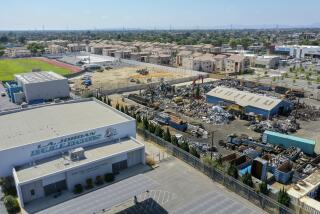School Employees to Vacate Offices in Polluted Area
SOUTH GATE â The Los Angeles Unified School District has decided to vacate its offices at a former school in an industrial area of South Gate after 15 employees complained of rashes, headaches and other health problems.
The last of the 20 employees at the former Tweedy Elementary School are scheduled to be moved to other district offices by the end of the week, Deputy Supt. Ruben Zacarias said. District officials said the move was precautionary and the district may decide to use the former school site in the future. The Los Angeles school district serves portions of the Southeast area, including South Gate.
âItâs not because we think itâs unsafe there,â said Susie Wong, the school districtâs director of environmental health and safety. âSome people were getting rashes out there and I donât know what to attribute it to.â
Training teacher Lee Saltz described the health problems to district officials in a Feb. 11 memo and asked that she and her co-workers be moved. Saltz and some of the other employees, including other teachers and clerical workers, said they believe they were being exposed to airborne contaminants from nearby industry.
âI am so thrilled to be out of here,â said Saltz, who has had a rash on her right leg intermittently for more than a year. âThe only thing Iâm concerned about now is we donât know the long-term implications. My rashes are still on my leg.â
Saltz said she will consider taking legal action against the district if her health problems continue.
Much of the health concerns focused on Cooper Drum Co., which is next door to the former elementary school. The firm, which recycles 55-gallon steel drums for industrial use, is a candidate for the national Superfund List that targets the nationâs most polluted areas for cleanup. There is soil and ground-water contamination at Cooper Drum, according to U.S. Environmental Protection Agency officials.
But so far, EPA officials say there is no evidence linking Cooper Drum and the health problems of the school districtâs employees. An EPA inspector visited Cooper Drum and Tweedy school last month but was unable to detect any environmental hazards at the site.
Also, the South Coast Air Quality Management District sent out inspectors three times in January and February to investigate complaints of odors at the former school--the smell of solvents or burning wood. But the inspectors found nothing, a AQMD spokeswoman said.
Cooper Drum officials said the plant is operating in accordance with its permits and that it does not pose a health hazard.
Environmental pollutants have been a concern at Tweedy since the mid-1980s because the school is surrounded by industry.
School employees and students complained of headaches, stomachaches, nausea, sore throats, swollen eyes, respiratory problems and allergies.
The school district, facing strong public pressure, closed the school in 1988 even though AQMD air monitoring at the school in 1987 found no dangerous pollution levels, officials said.
The district reopened the buildings in September, 1989, and assigned about 20 employees to work there full-time. District psychologists and nurses also used the former school occasionally to test students.
The employees said they started experiencing health problems more than a year ago. Fifteen of the 20 employees assigned to the site said they developed rashes, headaches and allergies since being assigned to Tweedy. Two workers said they sometimes have become nauseated on the school grounds.
Most of the employees said they saw private doctors, who were unable to pin down the cause of their problems. They were given ointments to treat the rashes, which recurred. Some of the employees said their rashes would clear up when they were away from Tweedy on vacation.
The employeesâ fears increased last month when the EPA announced that it has proposed putting Cooper Drum on the national Superfund list.
During limited testing, the last of which took place in 1990, environmental officials discovered tainted soil at depths of 30 feet below the ground and polluted water 53 feet below the ground at Cooper Drum. The soil and ground water contained the industrial degreasing solvent perchloroethylene, or PCE, and other chemicals, including cancer-causing vinyl chloride and benzene.
Environmental officials say they are most concerned because the pollution has the potential to reach a major aquifer 600 feet below the ground. The aquifer is the source of drinking water for South Gate and other cities in the Southeast Los Angeles County area.
The EPA will conduct extensive tests of the soil and ground water in and around Cooper Drum if the site is added to the Superfund List as expected in the next several months.
More to Read
Sign up for Essential California
The most important California stories and recommendations in your inbox every morning.
You may occasionally receive promotional content from the Los Angeles Times.










